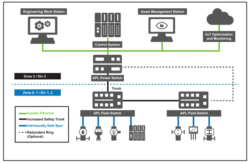“The realization of this vision began in 2011, when a group of solution suppliers at the urging of several end user groups began a technical investigation of a protocol-neutral, advanced physical layer (a.k.a., APL) that could solve the longtime problem of a long-reach Ethernet for use in hazardous locations.” APL White Paper
Description
In order to turn concepts like Industry 4.0 and the Industrial Internet of Things (IIoT) into a reality, PI is investing in new technologies to enable these trends. One of these new technologies is APL or Advanced Physical Layer. The goal of APL is to bring Ethernet down to field level instruments in hazardous areas. Nowadays, existing field devices typically rely on limited fieldbus network infrastructures. Taking process industries into the future requires a new network standard to transfer process data with standard Ethernet and IP technologies.
Ethernet in the field level will make digitalization for process industries a reality. Ethernet adds its universality and speed to existing field device installations. Current and voltage will be limited to have an intrinsically safe solution for zones 0 & 1 / Div 1. The physical connection is a rugged two-wire connection with power over this 2 wire cable. Finally, APL will exceed the 100m limit currently imposed on common 100BASE-TX Ethernet networks.
APL Topology
The APL switched architecture eliminates any unwanted interference between devices connected to the same network. The main goal is to adopt proven technologies and options in the field of process automation. The general topology will be based on the well know Trunk-and-spur configuration.
Trunk
- Mechanical methods such as increased safety transfer the maximum specified power into the hazardous area.
- Installation in hazardous areas Zone 1, Div 1
- Cable length <= 1000m @ 10Mbps full duplex
Spur
- Intrinsic safety is supported at the spur.
- Installation in hazardous areas Zone 0, Div 1
- Cable length <= 200m @ 10Mbps full duplex
- Intrinsic Safety verification similar to FISCO
- 2-wire, shielded IEC61158 type A fieldbus cable
More information HERE: APL, TSN, OPC UA, PROFINET Webinar
-Nelly Ayllon

